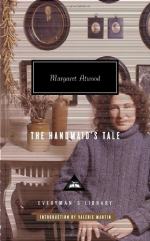|
This section contains 4,215 words (approx. 15 pages at 300 words per page) |

|
SOURCE: “Nature and Nurture in Dystopia: The Handmaid's Tale,” in Margaret Atwood: Vision and Forms, edited by Kathryn VanSpanckeren and Jan Garden Castro, Southern Illinois University Press, 1988, pp. 101-12.
In the following essay, Rubenstein examines the use of nature imagery and symbolism to portray female sexuality, reproduction, and maternity in The Handmaid's Tale.
I
One might say that Margaret Atwood has always been concerned with issues of survival—first as a condition of Canadian experience and, more recently, as a condition of female experience. In her latest fiction and poetry, she connects the personal and political dimensions of victimization and survival in explicitly female and feminist terms. Moreover, in the course of her fiction the terms of survival have become increasingly problematic. In her fablelike The Handmaid's Tale, she stunningly extends, recasts, and inverts two of the most persistent clusters of theme and imagery that originate in her...
|
This section contains 4,215 words (approx. 15 pages at 300 words per page) |

|


